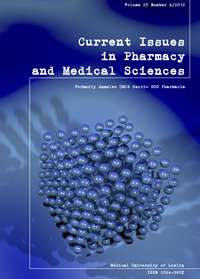Blood serum free light chain concentration vs. Imunofixation results in patients with monoclonal gammapathy
DOI:
https://doi.org/10.12923/j.2084-980X/25.4/a.19Słowa kluczowe:
free light chains, monoclonal gammapathy, immunofixationAbstrakt
Monoclonal gammapathies are a group of diseases characterized by proliferation of plasma clone cells that produce a certain type of homogenic immunoglobulin containing heavy chains of a, g, m, d, e class aside a type of light k or l chains. Standard methods applied to detect and identify the type of monoclonal protein in patients suspected of monoclonal gammapathy include serum electrophoresis and immunofixation. Quantitative analysis of free light chains (FLCs) by nephelometry has become more popular recently. The purpose of the study was to compare the results and assess the compatibility of free light chains measurements obtained by nephelometry and standard immunofixation. In addition to that, we tried to evaluate the usefulness of serum FLC analysis in the detection of monoclonal protein. The investigation was carried out in the group of 92 patients with suspected monoclonal gammapathy. In most cases concentrations of FLCs are increased depending on the type of light chain determined by immunofixation, however normal values of FLCs and normal kappa/lambda ratio do not exclude the presence of monoclonal protein. The analysis of FLC is most useful to identify patients suspected of light chain disease. Immunofixation is more sensitive method to detect gammapathies with complete monoclonal protein in comparison to quantitative FLC analysis.
Bibliografia
1. Abraham R., Clark R., Bryant S et.al.: Correlation of serum immunoglobulin free light chain quantification with urinary Bence Jones protein in light chain myeloma. Clin. Chem., 48, 655, 2002.
2. Bradwell A.R., Carr-Smith H.D., Mead G.P. et.al.: Highly sensitive, automated immunoassay for immunoglobulin free light chains in serum and urine. Clin. Chem., 47, 673, 2001.
3. Drayson M., Tang L.X., Drew R. et. al.: Serum free light-chain measurements for identifying and monitoring patients with nonsecretory multiple myeloma. Blood, 97, 2900, 2001.
4. Gajos A., Kieliś W., Szadkowska I. et. al.: Acquired peripheral neuropathies associated with monoclonal gammopathy. Neurol. Neurochir. Pol., 41, 169, 2007.
5. Jaskowski T.D., Litwin C.M., Hill H.R. et.al.: Detection of kappa and lambda light chain monoclonal proteins in human serum: automated immunoassay versus immunofixation electrophoresis. Clin. Vaccine Immunol., 13, 277, 2006.
6. Jurczyszyn A., Skotnicki A.B.: Szpiczak mnogi – kompleksowa diagnostyka i terapia, Wgórnicki wydawnictwo medyczne, 2010.
7. Katzmann J.A., Abraham R.S., Dispenzieri A. et.al.: Diagnostic performance of quantitative kappa and lambda free light chain assays in clinical practice. Clin. Chem., 51, 878, 2005.
8. Katzmann J.A., Clark R.J., Abraham R.S. et. al.: Serum reference intervals and diagnostic ranges for free kappa and free lambda immunoglobulin light chains: relative sensitivity for detection of monoclonal light chains. Clin. Chem., 48, 1437, 2002.
9. Kendziorek A., Bobilewicz D.M.: Badania laboratoryjne w różnych stadiach rozwoju gammapatii monoklonalnych. In Vitro Explorer, 1, 3, 2007.
10. Kendziorek A., Bobilewicz D.M.: Wartość oznaczeń immunoglobulin w różnych grupach wiekowych. In Vitro Explorer, 1, 12, 2006.
11. Kraj M., Kruk B., Pogłód R.: Kliniczna wartość ilościowych oznaczeń wolnych lekkich łańcuchów immunoglobulinowych w surowicy chorych na szpiczaka plazmocytowego. NOWOTWORY, 61, 355, 2011.
12. Kyle R.A., Durie B.G., Rajkumar S.V. et. al.: Monoclonal gammopathy of undetermined significance (MGUS) and smoldering (asymptomatic) multiple myeloma: IMWG consensus perspectives risk factors for progression and guidelines for monitoring and management. Leukemia, 24, 1121, 2010.
13. Lachmann H.J., Gallimore R., Gillmore J.D. et. al.: Outcome in systemic AL amyloidosis in relation to changes in concentration of circulating free immunoglobulin light chains following chemotherapy. Br. J. Haematol., 122, 78, 2003.
14. Mead G.P., Carr-Smith H.D., Drayson M.T. et. al.: Serum free light chains for monitoring multiple myeloma. Br. J. Haematol., 126, 348, 2004.
15. Mösbauer U., Ayuk F., Schieder H. et.al.: Monitoring serum free light chains in patients with multiple myeloma who achieved negative immunofixation after allogeneic stem cell transplantation. Haematologica, 92, 275, 2007.
16. Rajkumar S.V., Kyle R.A., Therneau T.M. et. al.: Serum free light chain ratio is an independent risk factor for progression in monoclonal gammopathy of undetermined significance. Blood, 106, 812, 2005.
17. Singhal S., Vickrey E., Krishnamurthy J. et. al.: The relationship between the serum free light chain assay and serum immunofixation electrophoresis, and the definition of concordant and discordant free light chain ratios. Blood, 114, 38, 2009.
18. Usnarska-Zubkiewicz L., Hołojda J., Kuliczkowski K.: Serum free light chain (sFLC) – diagnostic and prognostic value in plasma cell dyscrasias. Acta Haematol. Pol., 40, 349, 2009.
19. Wolff F., Thiry C., Willems D. et al.: Assessment of the analytical performance and the sensitivity of serum free light chains immunoassay in patients with monoclonal gammopathy. Clin. Biochem., 40, 351, 2007.
20. Wood P.B., McElroy Y.G., Stone M.J.: Comparison of serum immunofixation electrophoresis and free light chain assays in the detection of monoclonal gammopathies. Clin. Lymphoma Myeloma Leuk., 10, 278, 2010.
Pobrania
Opublikowane
Numer
Dział
Licencja
Prawa autorskie (c) 2012 Autorzy

Praca jest udostępniana na licencji Creative Commons Attribution-NonCommercial-NoDerivatives 3.0 Unported License.


